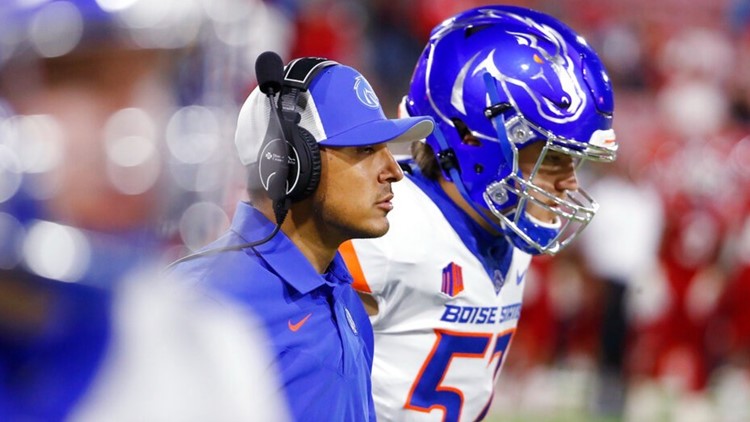BOISE, Idaho — This article originally appeared in the Idaho Press.
The list of state employees who make more than the governor’s salary has risen to more than 400 this year, according to a new state report, and it’s topped, as usual, by Boise State University’s head football coach.
The report looks at total salary, even if the pay doesn’t come from state funds; that’s the case with BSU coach Andy Avalos, whose $1.4 million annual salary is nearly twice as high as the second-ranking state employee. That second-ranking one? BSU head men’s basketball coach Leon Rice.
Idaho’s not alone in this, notes state Controller Brandon Woolf, whose office publishes the report each January. The same is true in most states.
THE TOP 10
Idaho’s top 10 highest-paid state employees, from all funds:
- Andy Avalos, Boise State University head football coach, $1.4 million
- Leon Rice, BSU head men's basketball coach, $784,197
- Marlene Tromp, BSU president, $425,006
- C. Scott Green, University of Idaho president, $419,994
- Jeramiah Dickey, BSU athletic director, $410,010
- Kevin Satterlee, Idaho State University president, $400,000
- Robert Maynard, chief investment officer, Public Employee Retirement System of Idaho, $359,902
- John Buckwalter, BSU provost and vice president for academic affairs, $335,008
- Richard Ferguson, CEO of the Idaho State Insurance Fund, $325,021
- Torrey Lawrence, provost and executive vice president, University of Idaho, $321,298
According to 2019 data compiled by USA Today, the highest-paid state employee in 40 of the 50 states was a university football coach. Topping the list that year were University of Alabama coach Nick Saban and Clemson University coach Dabo Swinney, each pulling in around $9 million a year.
“Coach Avalos’ and Coach Rice’s salaries, like their predecessors, are not funded by the state, but by program revenue, sponsorships, and the generous contributions of donors,” BSU spokesman Mike Sharp said in an email to the Idaho Press.
“Boise State athletics competes at an elite, national level and its programs are widely recognized as some of the State of Idaho’s most visible brands,” he said. “Expectations for our programs as well as the national market for highly-skilled coaches set the price.”


Idaho Gov. Brad Little’s $138,302 salary ranks 29th among the states, according to the Council of State Governments. The ranking doesn’t take into account Little’s housing stipend, which comes to nearly half as much as his annual salary, but it also doesn’t count what other states spend to provide housing for their governors, which all but five states provide.
The list of state employees who make more than the governor’s $138,302 annual salary has grown steadily from 81 in 2001 to 407 this year; most of the top earners are at Idaho’s universities, along with doctors, Supreme Court justices and agency heads.
Also on the list: The governor’s chief of staff; every state district judge; top university officials, coaches and faculty; physicians employed by the state Department of Health and Welfare; the investment manager for the state retirement fund; every state district judge; and top executives of most state agencies.
The Idaho state controller’s office prepares the report for legislators each year on the state’s payroll and workforce; it includes active employee counts by agency, elected officials and their salaries, agency heads and their salaries, and the highest-paid employees report, listing all those who make more than the governor’s salary. In 2017, there were 338 state employees on the list; in 2008, there were 284.
Woolf said a look back at previous reports in his office showed that in 1983, just 35 state employees made more than then-Gov. John Evans’ $50,000 annual salary. At that point, the highest-paid state employee was the state health officer, who made $68,016.
These days, more than half of those on the list are at Idaho’s three universities. “I think it’s the market that universities are in,” Woolf said. “That’s the market value or going rate for these university employees.”
Sharp noted that BSU’s employee salaries overall are 10% below market rates.
For many years, the report was called the “Rainbow Report,” because it was printed on stacks of multi-colored paper. It went from there to a CD to just being on the web. It’s now called the Legislative Handbook, but all its reports are available to anyone, any time on the controller’s Transparent Idaho website, with data updated daily.
Woolf said the report is always popular with high school groups or others who tour his office to learn about what the state controller does. “It’s one of my favorites,” he said.
This article originally appeared in the Idaho Press, read more on IdahoPress.com.
Watch more Local News:
See the latest news from around the Treasure Valley and the Gem State in our YouTube playlist:



